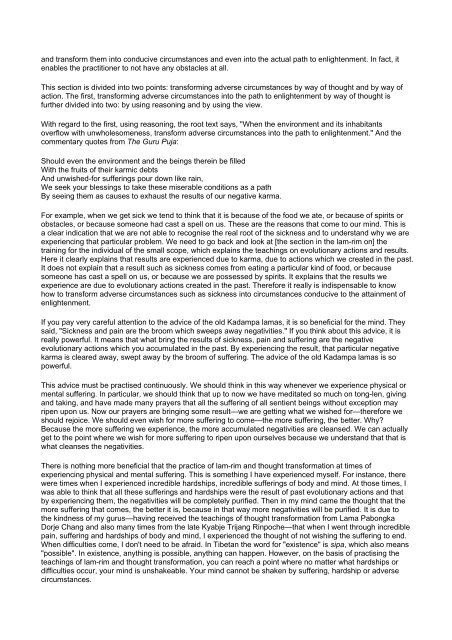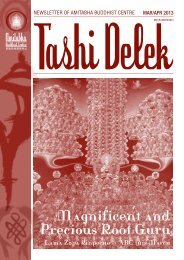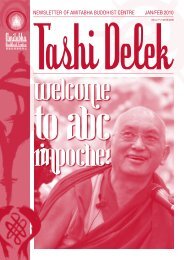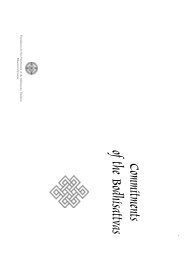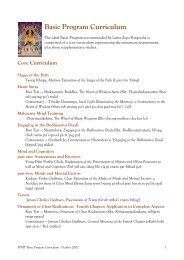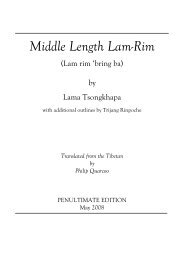How to Generate Bodhicitta (English) - Amitabha Buddhist Centre
How to Generate Bodhicitta (English) - Amitabha Buddhist Centre
How to Generate Bodhicitta (English) - Amitabha Buddhist Centre
Create successful ePaper yourself
Turn your PDF publications into a flip-book with our unique Google optimized e-Paper software.
and transform them in<strong>to</strong> conducive circumstances and even in<strong>to</strong> the actual path <strong>to</strong> enlightenment. In fact, itenables the practitioner <strong>to</strong> not have any obstacles at all.This section is divided in<strong>to</strong> two points: transforming adverse circumstances by way of thought and by way ofaction. The first, transforming adverse circumstances in<strong>to</strong> the path <strong>to</strong> enlightenment by way of thought isfurther divided in<strong>to</strong> two: by using reasoning and by using the view.With regard <strong>to</strong> the first, using reasoning, the root text says, "When the environment and its inhabitantsoverflow with unwholesomeness, transform adverse circumstances in<strong>to</strong> the path <strong>to</strong> enlightenment." And thecommentary quotes from The Guru Puja:Should even the environment and the beings therein be filledWith the fruits of their karmic debtsAnd unwished-for sufferings pour down like rain,We seek your blessings <strong>to</strong> take these miserable conditions as a pathBy seeing them as causes <strong>to</strong> exhaust the results of our negative karma.For example, when we get sick we tend <strong>to</strong> think that it is because of the food we ate, or because of spirits orobstacles, or because someone had cast a spell on us. These are the reasons that come <strong>to</strong> our mind. This isa clear indication that we are not able <strong>to</strong> recognise the real root of the sickness and <strong>to</strong> understand why we areexperiencing that particular problem. We need <strong>to</strong> go back and look at [the section in the lam-rim on] thetraining for the individual of the small scope, which explains the teachings on evolutionary actions and results.Here it clearly explains that results are experienced due <strong>to</strong> karma, due <strong>to</strong> actions which we created in the past.It does not explain that a result such as sickness comes from eating a particular kind of food, or becausesomeone has cast a spell on us, or because we are possessed by spirits. It explains that the results weexperience are due <strong>to</strong> evolutionary actions created in the past. Therefore it really is indispensable <strong>to</strong> knowhow <strong>to</strong> transform adverse circumstances such as sickness in<strong>to</strong> circumstances conducive <strong>to</strong> the attainment ofenlightenment.If you pay very careful attention <strong>to</strong> the advice of the old Kadampa lamas, it is so beneficial for the mind. Theysaid, "Sickness and pain are the broom which sweeps away negativities." If you think about this advice, it isreally powerful. It means that what bring the results of sickness, pain and suffering are the negativeevolutionary actions which you accumulated in the past. By experiencing the result, that particular negativekarma is cleared away, swept away by the broom of suffering. The advice of the old Kadampa lamas is sopowerful.This advice must be practised continuously. We should think in this way whenever we experience physical ormental suffering. In particular, we should think that up <strong>to</strong> now we have meditated so much on <strong>to</strong>ng-len, givingand taking, and have made many prayers that all the suffering of all sentient beings without exception mayripen upon us. Now our prayers are bringing some result—we are getting what we wished for—therefore weshould rejoice. We should even wish for more suffering <strong>to</strong> come—the more suffering, the better. Why?Because the more suffering we experience, the more accumulated negativities are cleansed. We can actuallyget <strong>to</strong> the point where we wish for more suffering <strong>to</strong> ripen upon ourselves because we understand that that iswhat cleanses the negativities.There is nothing more beneficial that the practice of lam-rim and thought transformation at times ofexperiencing physical and mental suffering. This is something I have experienced myself. For instance, therewere times when I experienced incredible hardships, incredible sufferings of body and mind. At those times, Iwas able <strong>to</strong> think that all these sufferings and hardships were the result of past evolutionary actions and thatby experiencing them, the negativities will be completely purified. Then in my mind came the thought that themore suffering that comes, the better it is, because in that way more negativities will be purified. It is due <strong>to</strong>the kindness of my gurus—having received the teachings of thought transformation from Lama PabongkaDorje Chang and also many times from the late Kyabje Trijang Rinpoche—that when I went through incrediblepain, suffering and hardships of body and mind, I experienced the thought of not wishing the suffering <strong>to</strong> end.When difficulties come, I don't need <strong>to</strong> be afraid. In Tibetan the word for "existence" is sipa, which also means"possible". In existence, anything is possible, anything can happen. <strong>How</strong>ever, on the basis of practising theteachings of lam-rim and thought transformation, you can reach a point where no matter what hardships ordifficulties occur, your mind is unshakeable. Your mind cannot be shaken by suffering, hardship or adversecircumstances.


